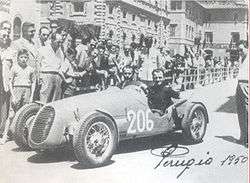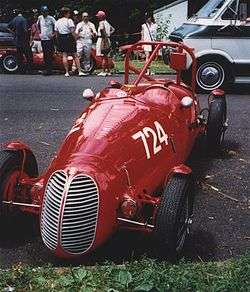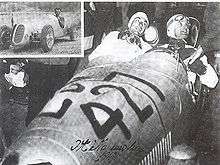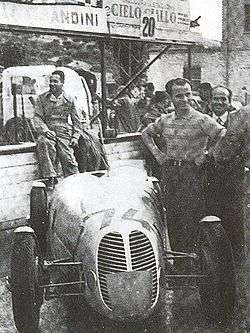Bandini 1100 siluro
The Bandini 1100 Siluro is a racing car produced from 1947 to 1949 by Bandini Automobili in Forlì, Italy.




The 1100 Siluro was the first Bandini model created expressly for racing. The style and materials were selected for speed, performance and weight-savings. The name Siluro (English: torpedo) was chosen to acknowledge the aerodynamic shape and was thought to be a good omen for the races. Initially, to reduce weight and simplify repairs, they were not even painted.
The 1100 Siluro first participated in competitions in 1949. These included Italian competitions such as the "Giro dell'Umbria" (Lap of Umbria), the "Pescara Circuit", and the "Senigallia Circuit", as well as more important, internationally recognized events, such as Mille Miglia. It was driven by Richard W. Gent at Watkins Glen in the 1951 Grand Prix,[1] introducing the cars to the auto-sports fans of the United States.
The body
The body had two seats and was made of aluminium. It was built at the Bandini headquarters in Via Cesare Battisti in Forlì. Small motor-cycle style wheel-guards were fitted, allowing them to remain separate from the body. The overall result is a combination of technology and aerodynamically efficient torpedo styling, as well as being described as having elements from the animal kingdom. Ilario Bandini loved to reiterate that nature had solved very well functional problems that man is only beginning to face. Thus, he said, the grille, designed to direct as much air to the engine without overloading the front section, has the characteristics of enormous nostrils; lights are encased in it as the eyes of a fish, the heat is disposed of using louvers resembling the gills of a shark. In order to reduce weight as much as possible, the tail was very short and round and only the passenger had a door.
The chassis
The frame, a refinement of the 1100 sport frame, is the version developed for competition. The size and weight are reduced significantly. The height from the ground is 13 cm (5 in), while the bare chassis weighs only 25 kg (55 lb).
- Structure and material: frame of elliptical section tubes, aviation grade steel
- Suspension:
- Braking system:
- Service: hydraulics, drum front and rear
- Parking Mechanical tape, on transmission
- Steering: worm drive
- Wheels: Borrani Ray
- Fuel Tank: 50 L (13 US gal; 11 imp gal)
- Transmission: transmission shaft with central rear differential and halfshaft
The engine
The chassis, designed to accommodate modified Fiat 1100 engines, proved suitable for different engines up to 1500 cc engine capacity.
1100 DOHC version
- Positioning: forward longitudinal, 4-cylinder in-line
- Displacement: 1089 cc
- Bore and Stroke: 68 mm x 75 mm
- Head: Derived Alfa Romeo 6 adapted to the 4-cylinder engine, 2 inclined valves per cylinder, 2 camshafts controlled by chain and gears
- Power maximum: 65 hp (48 kW)
- Fuel system: 2 carburettors
- Lubricate: wet sump with pump gear and vertical cooler on the front
- Cooling: forced liquid with centrifugal pump and cooler on the front
- Gearbox and clutch: 4 speed+ RG, clutch single dry disc
- Ignition and electrical system: coil and distributor battery 12 V and generator
Fiat-Siata 1500 version
- Positioning: forward longitudinal, 4-cylinder in-line
- Displacement: 1496 cc
- Power maximum: 90 hp 6000 rpm
- Fuel system: 2 carburettors
- Lubrication: wet sump with pump gear and vertical cooler on the front
- Cooling: forced liquid with centrifugal pump and cooler on the front
- Gearbox and clutch: 4 speed + RG, clutch single dry disc
- Ignition and electrical equipment: coil and distributor, battery 12 V and generator
- Weight total: 485 kg (1,069 lb)
References
- "1947 Bandini Siluro news, pictures, specifications, and information". Conceptcarz.com. Retrieved 31 May 2014.